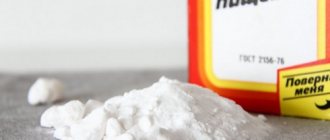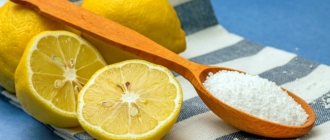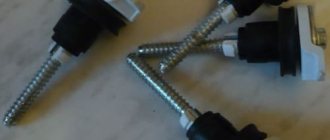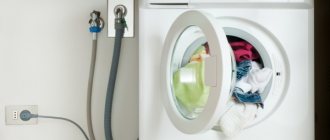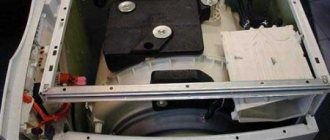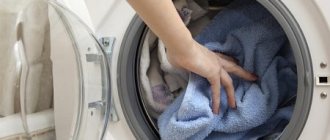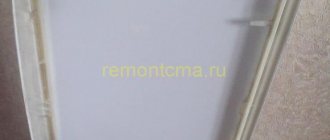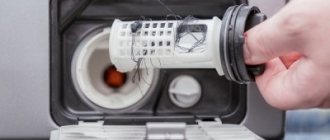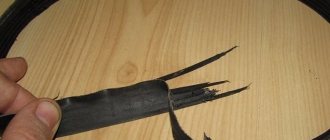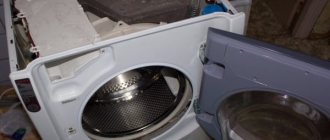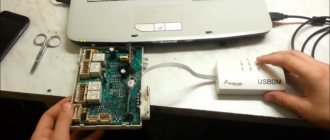Is it possible to clean a washing machine with vinegar?
During operation, the washing machine interacts with a large amount of tap water. Unfortunately, the latter is not of high quality; most often the water in the pipes is hard, with a large number of mineral impurities. Therefore, over time, scale forms on the internal parts of the machine, impairing the operation of the unit.
Cleaning the washing machine is required not only because of scale. After numerous washes, ordinary dirt accumulates in the device - small threads, hair, pet hair. Powder residues may settle in the drum and tray, and mold will gradually develop due to increased humidity.
Vinegar helps remove scale from the internal parts of the washing machine.
Regular cleaning of the unit helps eliminate scale, fungus and bacteria. You can use regular vinegar as a cleaning agent. It has good disinfectant and dissolving properties, removes limescale and eliminates unpleasant odors.
We recommend reading: How to remove brilliant green from linoleum
Causes of scale, unpleasant odor and dirt in the washing machine
The main enemies of washing machines are scale and unpleasant odors. The first is formed as a result of heating water. Liquid molecules are separated into vapor and insoluble components, which are deposited on the device. If the water is hard, the amount of scale that forms doubles.
Dirt accumulates in the detergent loading compartment and on the appliance parts located inside the machine. A large amount of moisture promotes the growth of mold. Scale forms on the surface of the drum and heating element, which is responsible for heating the water. It reduces the service life and causes damage to the device. In addition, sediment on the inside of the machine worsens the quality of washing and increases energy consumption.
Causes of dirt:
- the device is not ventilated after washing;
- low-quality powder is used;
- lack of device maintenance;
- incorrect dosage of detergents;
- frequent washing of clothes at low temperatures;
- residual liquid in the rubber cuff of the machine;
- using excessive amounts of conditioner.
Mold and various contaminants contribute to the appearance of an unpleasant odor. To get rid of stench, take care of your washing machine at home.
The most commonly used acid for cleaning is 9%
What kind of vinegar is added to the washing machine?
Universal table vinegar 9% is suitable for caring for household appliances; it can be poured into the tray undiluted. But if you don’t have such a product at hand, you can clean the washing machine with 70 percent vinegar. First you just need to dilute the essence with water in a ratio of 1 to 7.
9% acetic acid is best for cleaning a washing machine.
How to clean a washing machine with essence and soda
You cannot use 70% essence to clean a washing machine due to its high acid concentration. Before carrying out the procedure, dilute the preservative to 9%.
For one part acid, take 7 parts water. To clean the machine you will need 700 - 800 ml of solution. Take 100 ml of preservative and dissolve in 700 ml of liquid. Add 2.5 cups of soda and stir. Pour the resulting solution into the hole for detergents. Select long mode and maximum temperature.
As soon as the water heats up, stop operating the device for 1 hour. After the time has passed, resume washing and wait until the cycle ends. Then wipe the rubber band and remove any remaining liquid from it.
Soda ash combined with acetic acid softens hard deposits. The effect of the procedure lasts for 2-3 months.
Acid and soda also cope with other problems, including in cooking. They replace baking powder. At home, you can clean the carpet with baking soda and vinegar.
See how to get rid of mold in your washing machine:
How to clean a washing machine with vinegar and soda
The internal cleaning of an automatic machine can be done in two ways. The most common one suggests using only a vinegar solution to care for the unit; another option recommends adding soda powder.
We recommend reading: Baking soda: beneficial properties, uses, how to take
The traditional option for cleaning a washing machine with vinegar
To clean your washing machine with vinegar from odors and scale, you need to follow this algorithm:
- The laundry is unloaded from the drum of the device and checked to see if there are any unnoticed small items left inside.
- 150 ml of acetic acid 9% is poured into the powder compartment. If necessary, you can mix 70% vinegar essence and water in a ratio of 1 to 7, and then pour the same 150 ml of solution into the tray.
- The door of the automatic machine is closed and the unit is set to the longest washing cycle at a water temperature of 60 degrees and above.
- 20-30 minutes after the start of washing, stop the operation of the automatic machine by pressing the pause button, and leave the unit in this state for 1.5 hours.
- During the specified period, the vinegar solution will have time to interact with all parts of the machine and will penetrate even into hard-to-reach places of the unit. When 1.5 hours have passed, the wash cycle will need to be resumed and wait until the end of the program.
To clean, you need to pour no more than 150 ml of vinegar into the machine tray.
Once cleaning is complete, you will need to unplug the washing machine, remove the drain filter located at the back of the device, and manually clean it of any remaining scale and dirt. After this, you will need to dilute another 50 ml of vinegar essence in 1 liter of water, moisten a sponge in the solution and wipe the inside of the unit drum and the door from the inside.
After cleaning with vinegar, it is recommended to remove and wash the drain filter separately.
After installing the cleaned drain filter in place, the machine is plugged in again and the wash is started again. This time no cleaning agents are added to the powder tray, and the shortest program is selected; repeated washing is needed to simply remove the remaining vinegar solution and scale from the unit.
Attention! All manipulations when cleaning the machine should be carried out wearing rubber gloves and a gauze bandage for the face. Vinegar solution is a fairly caustic household product, so it is better not to inhale its vapors and avoid getting the liquid on your skin.
Cleaning the washing machine with vinegar and soda
If there is a strong unpleasant odor from the unit and serious scale, you can also use baking soda. The algorithm in this case will look a little different:
- 50 g of soda powder is diluted with 50 ml of water to a paste;
- the product is placed in the washing powder tray;
- 200 ml of vinegar essence 9% is poured into the empty drum of the machine;
- run the machine in intensive wash mode at a temperature of 60 to 90 ° C for the longest cycle.
When cleaning with soda, acetic acid is poured into the drum, and soda powder is poured into the tray.
The spin cycle must be turned off when cleaning; if there is no laundry in the drum, this mode will not be needed.
Baking soda and acetic acid will have a double effect and help cope with even the most severe stains. At the end of the washing cycle, you will need to manually clean the drain filter in the same way and wipe the inside of the drum, and then start the machine without cleaning agents to rinse it with water from the inside.
Cleaning the washing machine from dirt using acetic acid
Regular vinegar will help remove stains. Pour 200-250 ml of acid into the powder compartment. Select the high temperature mode and start the device. As soon as the water heats up, press pause and stop the machine for 1 hour.
After the specified time has elapsed, start the mode. Wait until the washing machine finishes operating. Then clean the drain filter from accumulated scale.
To clean the washing machine drum and rubber cuff, prepare a solution of 500 ml of water and 50 ml of preservative. Run the device, but at minimum mode, to remove any remaining acid from the surface of the device.
Household appliances are cleaned with acid. To clean the oven with vinegar, wear gloves.
Author's note
Kirilova Olga
There should be no laundry in the washing machine during cleaning.
Cleaning with vinegar should be done once every six months.
Is vinegar harmful to a washing machine?
It's quite easy to descale your washing machine with vinegar. But despite its high efficiency and availability, the solution has some disadvantages; it can cause harm to the machine if used incorrectly or too frequently:
- The pungent smell of acetic acid after cleaning can remain in the machine for a long time. That is why it is important to put the unit into operation again after the cleaning is completed, this will allow the remaining solution to be washed out of the internal parts. You need to pour the strictly recommended amount of acetic acid into the detergent tray, no more than half a glass.
- The vinegar solution is completely harmless to the metal parts of the unit. But at the same time, it can damage silicone and rubber elements, primarily the sealing collar. As a result of cleaning, the elastic can become stiff and simply tear, so the procedure should not be carried out too often.
Acetic acid is dangerous for the rubber cuff, so after cleaning it must be rinsed separately
After cleaning, you need to open the drum of the unit and thoroughly rinse the cuff with a clean, damp sponge to remove any remaining vinegar solution. The drum and tray are left open for several hours or even a couple of days, this will help ventilate the device.
Advice! If the strong vinegar smell does not go away for a long time, you can run the machine in the “empty” wash mode and add a little scented fabric softener to the tray.
Advantages and disadvantages of cleaning a machine with acetic acid
Acetic acid will help descale your washing machine and eliminate unpleasant odors. The method has undeniable advantages:
- high efficiency is achieved due to the destructive effect of acid on scale particles;
- disinfection;
- elimination of unpleasant odor;
- acid destroys bacteria;
- low cost;
- safety.
Disadvantages include the strong smell of acid and the risk of damage to the rubber parts of the device.
Table vinegar 3, 6, 9% is suitable for cleaning. A higher concentration of preservative cannot be used. Otherwise, there is a risk of damage to the components of the laundry appliance.
Acid is a universal remedy that solves everyday problems. Many people use vinegar for bedbugs.
Author's note
Kirilova Olga
To avoid harm to the washing machine, do not exceed the permissible concentration of preservative.
Essence 70% cannot be used in its pure form.
Useful tips
If you follow a few simple recommendations when using an automatic washing machine, you will rarely need to clean the unit:
- The main cause of washing machine breakdowns is hard tap water with a high content of foreign impurities. To protect the internal parts of the machine from scale, it is recommended to install water filters. If this is not possible, you should use water softeners, for example, Calgon.
- In addition to chemicals, ordinary household products can help soften water. When washing, you can add baking soda to the detergent tray from time to time; it has a positive effect on the composition of the water and makes it less hard.
- In addition to scale, the automatic machine is damaged by fine dirt, which accumulates over time on the internal elements of the unit. Before washing, it is recommended to carefully check the pockets of clothing, as well as shake off items and brush them to remove small threads, hair, wool and dust particles.
- The most vulnerable parts of the washing machine are the sealing collar and the drain filter. Once every 2 months it is recommended to carry out a small cleaning of these elements. The cuff on the machine hatch can be regularly wiped with soapy water; the filter must be unscrewed and cleaned manually from accumulated debris.
When washing, you can use soda to soften the water, then scale will form more slowly
Important! It is recommended to disinfect a washing machine with vinegar no more than once every six months. With constant use of household solvent, the condition of the rubber elements will deteriorate, and the machine will, one way or another, require repair.
Cleaning the washing machine with bleach and acetic acid
Vinegar and bleach are effective remedies. They will not only remove dirt, but also eliminate the unpleasant rotten smell.
Pour 700 ml of white into the detergent compartment. Select fast mode and start the washing machine. When the device is finished operating, pour 2 cups of acid into the powder compartment. Select long mode at acceptable temperature. Start the device.
As soon as the water heats up, after about 20-25 minutes, press pause and stop the machine for 1-1.5 hours. After the time has elapsed, start the device again and wait until the operation is completed.
Open the washing machine door and ventilate. Remove accumulated liquid from the surface of the rubber cuff and wipe thoroughly with a damp cloth soaked in a solution of 200 ml of water and 2 tbsp. preservative.
Carry out the procedure once every six months. If the appliance has not been used for a long time, clean it before washing.
Watch the video on how to clean the machine:
Let's wipe down the body of the machine
Having taken care of the “insides” of the machine, we must not forget about its external parts. We are talking about the top cover of the machine, the dashboard, the glass of the hatch and the walls of the case, which inevitably become dirty and turn yellow. One damp cloth will not wash away all the residue that has adhered to the washer - adhered powder particles, room dust and rinse aid drips. Especially if the equipment is in the kitchen and gets dirty with grease and soot.
To remove all plaque and return the body to its original color, just turn to vinegar and soda again. We wet the sponge in diluted products and carefully go over the affected areas. The main thing is to wring out the cloth well, leaving it slightly damp so that moisture does not get inside the machine and damage the electronics.
Vinegar and soda are the most accessible and cheapest cleaners that can cope with scale and mold in the washing machine. You just need to calculate the dosage and start cleaning.
Interesting:
- Cleaning the washing machine with folk remedies
- Is it possible to add vinegar to an automatic washing machine...
- How to clean a washing machine with vinegar
- How to clean a washing machine from smells with vinegar?
- Secrets of cleaning the washing machine drum
- How to Clean a Dishwasher with Vinegar and Soda
Reader comments
- Share your opinion - leave a comment
How to replace vinegar when cleaning a machine?
Not only vinegar can be used to clean household appliances. There are several components found in every apartment. They will also cope with this task effectively.
The most common replacement options:
- Lemon acid. This component must be poured in an amount of 100-200 g (depending on the condition of the household unit) into the powder compartment or directly into the drum. The efficiency will be the same. Run a long wash with water heating to 90 degrees. When finished, check the drain filter and the rubber parts inside and, if necessary, remove any accumulated scale.
- Copper sulfate. The product is effective against unpleasant moldy odor and fungal infections. Its action does not harm the equipment. Before use, you need to dilute 30 g of vitriol in 1 liter of water. Treat the entire inside of the unit with the resulting solution using a sponge and leave for 24 hours. After the period has expired, the machine must be turned on to the washing mode, pouring any washing powder into the compartment. At the end of the procedure, carry out an additional rinse, and then wipe the inside with a dry cloth.
- Soda Ash. The difference between technical soda and baking soda is the acidity level - 11 units. You need to use soda ash carefully, because... it can cause skin irritation. The substance helps descale the washing machine much faster and more efficiently. For cleaning, it is enough to pour 50 g of the component.
Use vinegar separately
Vinegar is a great alternative to expensive store-bought cleaners. It eats away lime deposits, kills bacteria and eliminates unpleasant odors. It is not for nothing that acetic acid is used for sanitizing premises and for removing old grease stains.
Vinegar is also often used to clean washing machines. Unlike other folk and store remedies, it has the following advantages:
- affordable cost;
- disinfection properties;
- effective removal of mold and scale (deposits are dissolved to the smallest particles, rather than breaking off in pieces, which makes it easier to remove plaque from the machine);
- safety (subject to proper use).
As for the disadvantages of vinegar cleaning, there are two of them: a pungent odor of acid and the risk of damaging the rubber elements of the washer. But both “minuses” can be circumvented if you calculate the dosage and thoroughly rinse the machine after the procedure.
Acetic acid has disinfecting properties, kills bacteria, mold and corrodes scale.
In order for the acid to help remove scale safely and effectively, you must act strictly according to the instructions.
- Empty the drum - the wash should be “idle”.
- Wear rubber gloves and open the door for ventilation.
- Buy 9-10% vinegar or dilute 70% vinegar to the desired concentration (you need to mix acid and water in a ratio of 1 to 7).
- Pour the vinegar solution into the powder receptacle (the dosage depends on the capacity of the drum, usually 125-250 ml).
- Turn on high temperature and long mode (usually “Cotton”, “Children’s” or “Intensive”).
- Turn off spin and rinse.
- Start the wash, wait 10-20 minutes until the water in the tank heats up and pause (if there is no such function, then you need to disconnect the machine from the power supply).
- Leave the machine for 1.5-2 hours.
- After 1.5-2 hours, continue the cycle until completion.
That's not all. Now you should re-dilute the vinegar with water, soak a sponge in the resulting solution and clean the surface of the drum and the cuff with it. Afterwards the machine is closed and sent for rinsing or quick washing. Then we unscrew the garbage filter and rinse it from accumulated dirt. At the “finish”, wipe the body and tank dry with a rag, open the hatch with the powder receptacle and let the washer dry naturally.
Drum
Dirt and grease appear in the washing machine due to washing clothes in cold water. Due to low temperatures, they do not completely and insufficiently dissolve and spread to all parts of the unit.
This causes mold and film to form on the inside of the washing machine, in the detergent compartment or on the rubber seal.
After some time, this biofilm or mold begins to smell bad and accelerates the development of fungi and bacteria, which can attach to the laundry and invade other parts of the unit.
The appearance of scale also causes problems with the machine. In addition, the energy requirement increases significantly due to the calcination of the heating elements.
Sometimes this results in 30% more energy consumption than before. The technical condition and quality of laundry are deteriorating. The cost of operating a washing machine is rising. Therefore, you need to know how to clean a washing machine with vinegar.
If you want to fix the problem with this remedy at home, you need to pay attention to the dosage.
To decalcify the machine, vinegar is added both to the drum and to the detergent compartment. You can use pure vinegar, there will be no harm.
Pour into the tray with caution. It is correct to dilute it with water first. If pure vinegar gets into the tray, it will damage the plastic.
How to descale your washing machine:
- The first thing to do is remove all the items from the drum. This cleaner may damage some materials.
- To clean the machine from scale with vinegar, pour 200 ml of pure concentrated substance into the drum. If you pour the product into a powder receptacle, dilute it with 5 parts of water.
- To rinse the machine thoroughly, you need to select the longest cycle and a temperature of 60–90 degrees.
- If you can pause it, then after the water has heated up and gone through a few rotations, pause the device.
- After 1–1.5 hours, start the cycle again and rinse the washing machine with vinegar.
- Then you need to rinse again to remove the smell.
If the machine is heavily soiled, you can wash the machine with vinegar and soda. How to clean: mix the ingredients in equal parts, dilute with water and pour into a powder container. The wash cycle is the same.
How to descale a washing machine with citric acid
If you do not want to use vinegar due to its high toxicity and strong odor, use citric acid. This is an alternative product that has an effect on scale and dirt and extends the life of the device.
Take 5 sachets of the substance and pour the contents into the powder compartment. Select the long mode and maximum temperature, start the wash. After finishing the operation of the device, wipe the drum and also clean the rubber cuff. Carry out the procedure at least once every six months.
See how to properly use citric acid to clean your washing machine:
How does vinegar work?
Using vinegar for an automatic washing machine, you can quickly and cost-effectively clean the equipment from odors and dirt from the inside.
This product has powerful antibacterial properties that allow you to fight mold, unpleasant odors, mildew and scale in the washing machine without problems and additional costs.
By destroying dirt and pathogenic bacteria, the substance helps maintain freshness and cleanliness for a long time.
Advantages of the method
Cleaning your washing machine with vinegar at home has a number of advantages.
First of all, there is no need to purchase expensive chemicals - every housewife always has acetic acid at hand. At any time, you can dilute the solution and treat the equipment.
Vinegar easily helps to remove scale and other contaminants from the internal surfaces of equipment without causing harm.
Thanks to its antibacterial and disinfectant properties, the essence helps keep all parts of the device clean and fresh.
Due to its chemical activity, acetic acid easily copes with lime, dissolving it to the smallest particles, which are easily washed off with plain water.
Are there possible negative consequences?
In most cases, when aggressive substances are used correctly, there are no negative consequences. However, if you use not ordinary table vinegar, but an essence with a strength of 70%, rubber and plastic parts of the equipment may be damaged.
Therefore, when deciding to clean the washing machine with improvised means, it is important to correctly calculate the concentration of substances.
Is it possible to combine vinegar and soda?
In some cases, when the machine is heavily contaminated with mold and mildew, experts recommend cleaning the washing machine with vinegar and soda.
Soda has powerful antibacterial properties and actively destroys various microorganisms, so it can be used to disinfect the internal surfaces of the unit. The interaction of these tools will help you get better results in a short time and without additional costs.
